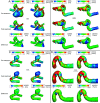Cerebral aneurysms treated with flow-diverting stents: computational models with intravascular blood flow measurements
- PMID: 23868162
- PMCID: PMC3858573
- DOI: 10.3174/ajnr.A3624
Cerebral aneurysms treated with flow-diverting stents: computational models with intravascular blood flow measurements
Abstract
Background and purpose: Computational fluid dynamics modeling is useful in the study of the hemodynamic environment of cerebral aneurysms, but patient-specific measurements of boundary conditions, such as blood flow velocity and pressure, have not been previously applied to the study of flow-diverting stents. We integrated patient-specific intravascular blood flow velocity and pressure measurements into computational models of aneurysms before and after treatment with flow-diverting stents to determine stent effects on aneurysm hemodynamics.
Materials and methods: Blood flow velocity and pressure were measured in peri-aneurysmal locations by use of an intravascular dual-sensor pressure and Doppler velocity guidewire before and after flow-diverting stent treatment of 4 unruptured cerebral aneurysms. These measurements defined inflow and outflow boundary conditions for computational models. Intra-aneurysmal flow rates, wall shear stress, and wall shear stress gradient were calculated.
Results: Measurements of inflow velocity and outflow pressure were successful in all 4 patients. Computational models incorporating these measurements demonstrated significant reductions in intra-aneurysmal wall shear stress and wall shear stress gradient and a trend in reduced intra-aneurysmal blood flow.
Conclusions: Integration of intravascular dual-sensor guidewire measurements of blood flow velocity and blood pressure provided patient-specific computational models of cerebral aneurysms. Aneurysm treatment with flow-diverting stents reduces blood flow and hemodynamic shear stress in the aneurysm dome.
Figures

Similar articles
-
Effects of flow-diverting device oversizing on hemodynamics alteration in cerebral aneurysms.AJNR Am J Neuroradiol. 2012 Nov;33(10):2010-6. doi: 10.3174/ajnr.A3080. Epub 2012 May 3. AJNR Am J Neuroradiol. 2012. PMID: 22555581 Free PMC article.
-
Computational hemodynamics analysis of intracranial aneurysms treated with flow diverters: correlation with clinical outcomes.AJNR Am J Neuroradiol. 2014 Jan;35(1):136-42. doi: 10.3174/ajnr.A3790. Epub 2013 Nov 28. AJNR Am J Neuroradiol. 2014. PMID: 24287091 Free PMC article.
-
How do coil configuration and packing density influence intra-aneurysmal hemodynamics?AJNR Am J Neuroradiol. 2011 Nov-Dec;32(10):1935-41. doi: 10.3174/ajnr.A2635. Epub 2011 Sep 1. AJNR Am J Neuroradiol. 2011. PMID: 21885712 Free PMC article.
-
High WSS or low WSS? Complex interactions of hemodynamics with intracranial aneurysm initiation, growth, and rupture: toward a unifying hypothesis.AJNR Am J Neuroradiol. 2014 Jul;35(7):1254-62. doi: 10.3174/ajnr.A3558. Epub 2013 Apr 18. AJNR Am J Neuroradiol. 2014. PMID: 23598838 Free PMC article. Review.
-
Basic Principles of Hemodynamics and Cerebral Aneurysms.World Neurosurg. 2016 Apr;88:311-319. doi: 10.1016/j.wneu.2016.01.031. Epub 2016 Jan 22. World Neurosurg. 2016. PMID: 26805691 Review.
Cited by
-
Flow diverter effect of LVIS stent on cerebral aneurysm hemodynamics: a comparison with Enterprise stents and the Pipeline device.J Transl Med. 2016 Jul 2;14(1):199. doi: 10.1186/s12967-016-0959-9. J Transl Med. 2016. PMID: 27370946 Free PMC article.
-
Standardized viscosity as a source of error in computational fluid dynamic simulations of cerebral aneurysms.Med Phys. 2024 Feb;51(2):1499-1508. doi: 10.1002/mp.16926. Epub 2023 Dec 27. Med Phys. 2024. PMID: 38150511 Free PMC article.
-
MR derived volumetric flow rate waveforms of internal carotid artery in patients treated for unruptured intracranial aneurysms by flow diversion technique.J Cereb Blood Flow Metab. 2015 Dec;35(12):2070-9. doi: 10.1038/jcbfm.2015.176. Epub 2015 Aug 12. J Cereb Blood Flow Metab. 2015. PMID: 26264871 Free PMC article.
-
Improving the accuracy of computational fluid dynamics simulations of coiled cerebral aneurysms using finite element modeling.J Biomech. 2023 Aug;157:111733. doi: 10.1016/j.jbiomech.2023.111733. Epub 2023 Jul 19. J Biomech. 2023. PMID: 37527606 Free PMC article.
-
In vitro, contrast agent-based evaluation of the influence of flow diverter size and position on intra-aneurysmal flow dynamics using syngo iFlow.Neuroradiology. 2017 Dec;59(12):1275-1283. doi: 10.1007/s00234-017-1903-2. Epub 2017 Aug 25. Neuroradiology. 2017. PMID: 28842742
References
-
- Lylyk P, Miranda C, Ceratto R, et al. . Curative endovascular reconstruction of cerebral aneurysms with the Pipeline embolization device: the Buenos Aires experience. Neurosurgery 2009;64:632–42 - PubMed
-
- Zhang Y, Chong W, Qian Y. Investigation of intracranial aneurysm hemodynamics following flow diverter stent treatment. Med Eng Phys 2013;35:608–15 - PubMed
-
- Piano M, Valvassori L, Quilici L, et al. . Midterm and long-term follow-up of cerebral aneurysms treated with flow diverter devices: a single-center experience. J Neurosurg 2013;118:408–16 - PubMed
Publication types
MeSH terms
Grants and funding
LinkOut - more resources
Full Text Sources
Other Literature Sources
Medical
